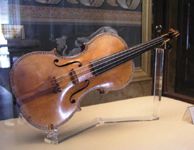End of the Spectrum: Spectroscopy Plays the Violin
Brian Johnson takes a look at two types of spectroscopy that help unlock the secrets of the famous Stradivarius violins.
Music aficionados have enjoyed the rich, soothing sounds of the violin for centuries, and arguably the most famous violins in history have come from the workshop of Antonio Stradivari. His line of Stradivarius violins have long been sought after by world-class musicians and collectors alike. Due to their limited availability (it is believed only 600 to 700 are still in existence), they command astronomical prices on the auction block. On May 16, 2006, a Stradivarius known as "The Christian Hammer" fetched a record price for a musical instrument at $3,544,000 at Christie's auction house in New York, New York.
Although Stradivari made several types of string instruments during his lifetime, including violas, cellos, mandolins, guitars, and even one harp, it is his violins that are considered superior to all others ever made. The main reason is due to their unsurpassed sound quality, for which scientists and researchers have been trying to find the secret for decades. Several theories abound as to how Stradivari made his violins so pitch-perfect, such as that he took the wood to make his instruments from an old cathedral, or that the type of glue he used had a profound impact on the sound. However, in the past, no one has been able to provide a proper explanation for Stradivari quality, and very few have been able to reproduce it in modern string instruments. But Joseph Nagyvary, a biochemist formerly of Texas A&M University, has struck a chord in finding the solution to the Stradivari mystery by using spectroscopy.

An authentic Stradivarius violin rests on display in the Royal Palace, Madrid, Spain.
Over a period of 20 years, Nagyvary was able to collect 80 milligrams of wood from the interior of three Stradivari instruments when they were sent away for repair or restoration. He and his colleagues then took the shavings back to their lab, where they used carbon-13 nuclear magnetic resonance spectroscopy and infrared spectroscopy to study the wood and find out exactly what these precious instruments were made of. What they discovered was that the outstanding sound of the instruments had less to do with the shape and quality of the wood and more to do with the chemical makeup of it. Nagyvary found that the wood used in Stradivari's instruments was dramatically different chemically from wood used in both modern instruments and instruments from the same time period made in England and France. Nagyvary believes that the violin backs were treated with wood preservers such as salts of copper, iron, and chromium, and that these salts were responsible for the eloquent sound. But the salts may also have altered the mechanical and acoustical properties of each instrument. A few years ago, Nagyvary found that treating maple with salt water and grape juice could produce a violin backboard similar to a Stradivarius. Later, he discovered that borax, used by Stradivari to prevent woodworm, had created a change in the wood that had a positive effect on the sound of the violin.
Nagyvary has made several violins by replicating Stradivari's techniques, with excellent results. In 2003, one such violin was tested head-to-head with a Stradivarius. Both violins were played behind a screen to an audience of trained musicians and music lovers. After both violins were played in four different pieces of music, the audience voted on each violin's tone qualities and projection. Surprisingly, Nagyvary's violin came out ahead, slightly outperforming the Stradivarius in each category.
Brian Johnson
Assistant Editor, Spectroscopy

New Study Reveals Insights into Phenol’s Behavior in Ice
April 16th 2025A new study published in Spectrochimica Acta Part A by Dominik Heger and colleagues at Masaryk University reveals that phenol's photophysical properties change significantly when frozen, potentially enabling its breakdown by sunlight in icy environments.